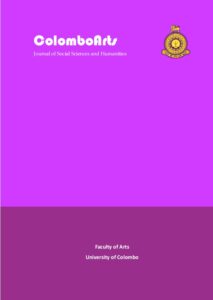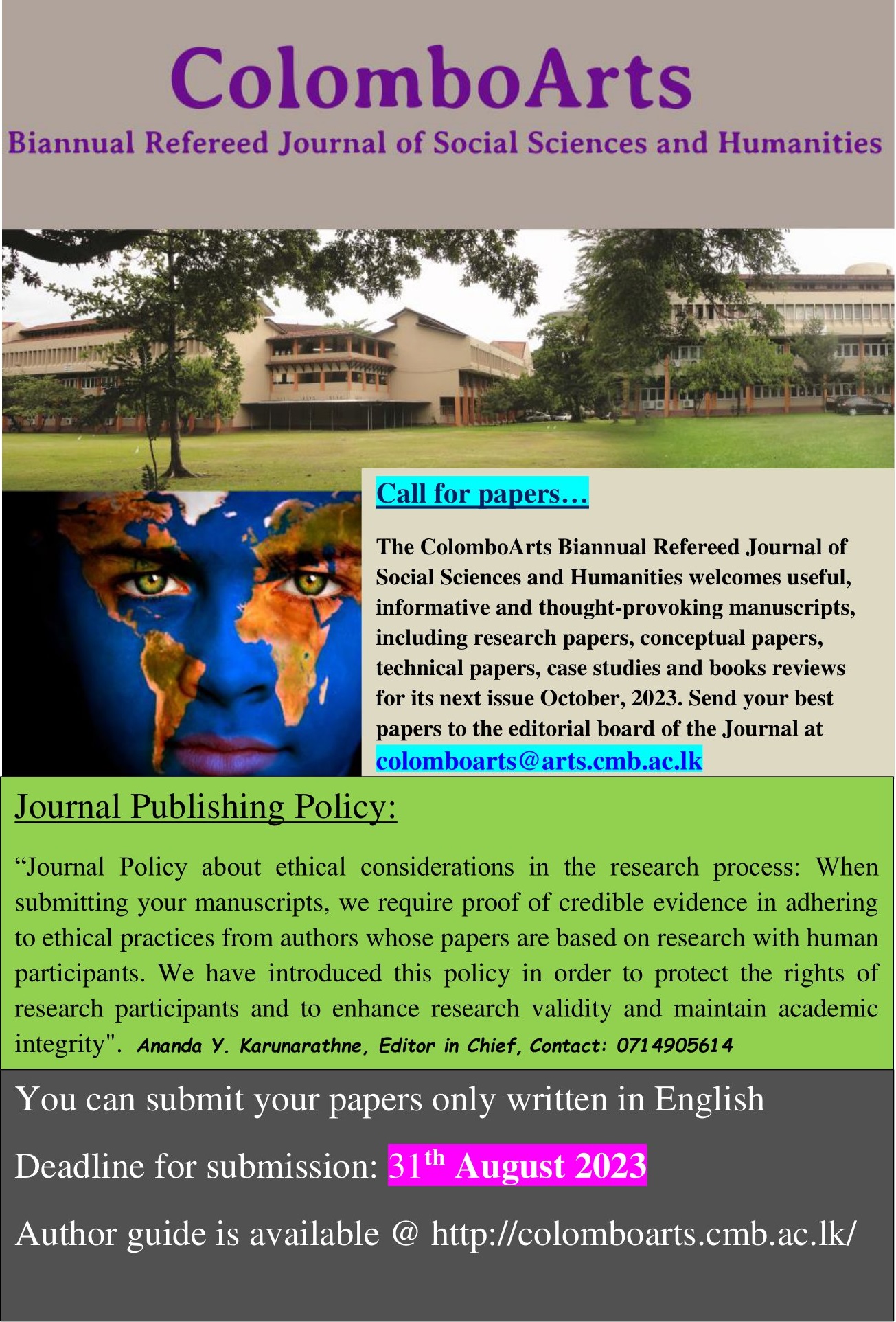ColomboArts eJournal
Biannual Refereed Journal of Social Sciences and Humanities

The ColomboArts Journal of Social Sciences and Humanities is the biannual on-line journal of the Faculty of Arts, University of Colombo. Its intention is to provide a platform for informative and thought-provoking research papers, conceptual papers, technical papers, case research and book reviews that specialize in social sciences and humanities. Articles are peer-reviewed by subject specialists and published in June and December each year under ISSN 2536-894X.
Consistent with the vision of the Faculty of Arts, the journal aims to be a platform of excellence in creative thinking, teaching, research and community outreach in the South Asian region.
The ColomboArts Journal of Social Sciences and Humanities is the biannual on-line journal of the Faculty of Arts, University of Colombo. Its intention is to provide a platform for informative and thought-provoking research papers, conceptual papers, technical papers, case research and book reviews that specialize in social sciences and humanities. Articles are peer-reviewed by subject specialists and published in June and December each year under ISSN 2536-894X.
Consistent with the vision of the Faculty of Arts, the journal aims to be a platform of excellence in creative thinking, teaching, research and community outreach in the South Asian region.
We wish to express our appreciation and thanks to all those who contributed towards the Second Issue of ColomboArts. Words are not adequate to express our gratitude and respect for Senior Professor Lakshman Dissanayaka, the Vice Chancellor of the University of Colombo, for his steerage. We also sincerely thank Senior Professor Premakumara de Silva, the Dean of the Faculty of Arts, who constantly guided and advised us throughout the publishing process. Further, we would like to convey our respect to Prof. Athula Ranasinghe, Former Dean, Faculty of Arts for initiating the ColomboArts E-journal.
Thanks are also due to the authors who submitted their research papers for consideration, the reviewers and also the Language Editor. Our Advisory Board furnished valuable guidance and saw us through to completion of the issue. The staff of the Student Computer Unit, Faculty of Arts, University of Colombo is also thanked for technical assistance.
ColomboArts Journal of Social Sciences and Humanities welcomes informative and thought provoking research papers from all areas of the Social Sciences and Humanities.
Co-editors
Faculty of Arts, University of Colombo
Current Editorial Board
Editor In Chief:
Ananda Y Karunarathne/PhD
Editors:
Priyanga Dunusinghe/PhD
Shravika D. Amarasekara/PhD
Jagath Bandara Pathirage/PhD
Darshi Thoradeniya/PhD
Assistant Editor:
Ms. Nadeesha D. Jayatunga
Copy Editor:
Ms. Nandula Perera
Editorial Advisory Board :
Senior Professor Lasantha Manawadu, Dean, Faculty of Arts, University of Colombo.
Professor Amala De Silva, Faculty of Arts, University of Colombo.
Professor Sandagomi Coperahewa, Faculty of Arts, University of Colombo.
Emeritus Professor Siri Hettige, Faculty of Arts, University of Colombo.
Emeritus Professor C.M. Maddumabandara, Faculty of Arts, University of Peradeniya.
Professor Edo Andriesse, Seoul National University.
Professor James Lewis, University of Tromsø.
Professor Ann Blackburn, Cornell University.
Professor Charles Hallisey, Harvard University.
Professor Jonathan Spencer, University of Edinburgh.
Current Issue
2022 : Volume 7, Issue I & II
Invited Paper
 Economic Crisis in Sri Lanka: The way-in and way-out
Economic Crisis in Sri Lanka: The way-in and way-out
Abeyratne, S.
 Open-book vs. closed-book examinations in higher education during COVID-19: The case of the Faculty of Arts, University of Colombo
Open-book vs. closed-book examinations in higher education during COVID-19: The case of the Faculty of Arts, University of Colombo
Pushpakumara, T.A.M.
 Students’ Perception on Online Learning During the Covid-19 Pandemic
Students’ Perception on Online Learning During the Covid-19 Pandemic
S.R.S.D.K. Weerawansa, T.U. Hewage
Book Review
 Book Review: Secrets of the Young and Successful: How to Get Everything You Want without Waiting a Lifetime by Kushnell, Jennifer and Kaufman, Scott M. 2003, New York: Fireside, 317 pages, paperback. ISBN 0-7432-2758-1
Book Review: Secrets of the Young and Successful: How to Get Everything You Want without Waiting a Lifetime by Kushnell, Jennifer and Kaufman, Scott M. 2003, New York: Fireside, 317 pages, paperback. ISBN 0-7432-2758-1
Raymund Sisenando R. Mercado
Author Guide
ColomboArts Journal of Social Sciences and Humanities accepts research papers from all areas of Social Sciences and Humanities. Papers are expected to conform to a high standard of academic rigor, scholarship and writing. Papers should be written according to the following guidelines.
1) Abstract
A. Should include research problem, methodology, major findings in brief
B. Font size 10/ single spaced/ Times New Roman/ in italics
C. Should be between 250 – 300 words
D. Maximum of five key words, arranged in the alphabetical order, below the abstract
2) Body of the text
A. Should include an introduction, body and conclusion
B. Titles and paragraphs should not be indented
C. Reference style: APA
3) General Format
A. MS Word 2016 or above
B. Page numbering: bottom, right, in Arabic numerals
C. Font: Times New Roman Size 12 / Justified
D. Subtopics: Times New Roman Size 12,boldfaced, left aligned
E. Language: English
F. Title page should include:
(a) title (less than 50 characters). Bold faced, font size 14
(b) name/s and affiliation/s of author/s.
(c) e-mail address and contact numbers of the corresponding author/s.
NOTE: Identify the corresponding author by placing an asterisk after the name.
4) Format for typesetting
A. Paper size: A4 (210 X 297 mm)
B. Margins: Top, bottom and right margins of 25 mm and a left margin of 30 mm
C. Line spacing: 1.5 (18 points) throughout the text
D. Length of the manuscript including text, tables, figures and references should not exceed 15 typed pages.
5) Tables and figures
A. Should be included within the text
B. Tables should be numbered sequentially using Arabic numerals. The titles should be self-explanatory. Figures should be numbered sequentially using Arabic numbers and be accompanied by a self-explanatory caption, left aligned. Titles of both Tables and figures should be of not more than 10 words.
C. Illustrations, line drawings and photographs, if any, should be clear, properly numbered and captioned and ready for reproduction (editable format).
D. All lettering, graph lines, and points on graphs should be sufficiently large to permit reproduction.
E. Lines of maps, artwork, and illustrations should be of appropriate thickness. Please note that thin lines do not reproduce well.
6) Acknowledgements
1. Based on necessity (Less than 100 words)
7) Acronyms and abbreviations:
All acronyms/ abbreviations should be written in full at the first appearance.
Book Review Guide
A full book review may concern only one book or monograph or several works. Its length is about 750-1000 words. It should give readers an engaging, informative, and critical discussion of the work. The review should follow the Guidelines below.
The most important point in developing a book review is to address the Journal’s readership: international and interdisciplinary. The review should consider:
- The intended audience for the book and who would find it useful;
- The background of the author;
- The main ideas and objectives of the book and how effectively these are accomplished;
- The soundness of methods and information sources used;
- The context or impetus for the book – political controversy, review research or policy, etc.;
- A comparison with other works on this subject;
- Constructive comments about the strength and weaknesses of the book;
- For edited books: dominant themes with reference to specific chapters as appropriate; and implications of the book for research, policy, practice, or theory.
The header of your review should include:
- Author(s) or editor(s) first and last name(s) (please indicate if it is an edited book)
- Title of book
- Year of publication
- Place of publication
- Publisher
- Number of pages
- Price (please indicate paperback or hard cover) if available
- ISBN
At the end of your review, please include:
- Your first and last name
- Institutional affiliation
- A brief biographical note along the line of:Breile Yahgis received her (degree) in (field) from….She is currently….[Where she teaches/conducts research/practices in….] Her interests include…etc.
Style Guidelines
- All references should be made in-text, rather than as footnotes or endnotes. These references should take the following form: (Smith 1999). If it is necessary to cite a particular page number, the reference should be in the following form: (Smith 1999, 27).
- Any such in-text references should be included in a separate Reference List, as shown in the following examples. (Please note capitalization and punctuation conventions.)
Book:
Holloway, Sarah and Gill Valentine, eds. (2000). Children’s Geographies: Playing, Living, Learning. London and New York: Routledge.
Book Chapter:
Jencks, Christopher and Susan Mayer(1990). “The Social Consequences of Growing up in a Poor Neighborhood.” In Lynn, Laurence and Michael McGeary, eds. Inner-City Poverty in the United States. Washington, D.C.: National Academy Press, 111-186.
Journal Article:
Gallagher, Claire B. (2004). “Our Town: Children as Advocates for Change in the City.” Childhood 11(2): 251-262
CAJ is an interdisciplinary journal. Authors must communicate to a wide audience with many readers in fields other than their own. Language must, therefore, be direct and void of unnecessary jargon and technical terms. Use the active voice as much as possible.
Call for Papers
The ColomboArts Journal of Social Sciences and humanities welcomes useful, informative and thought-provoking manuscripts, including research papers, conceptual papers, technical papers, case studies and books reviews for next issue. Send your best papers to the editorial board of the Journal at colomboartsejournal@gmail.com
You can submit your paper in English medium only.
Before 31st August 2023
For submission guidelines – http://colomboarts.cmb.ac.lk/?page_id=8

